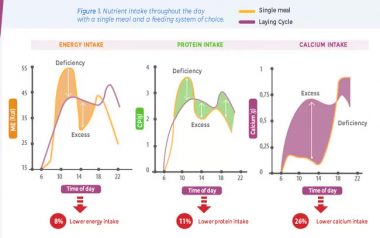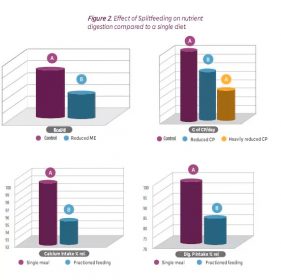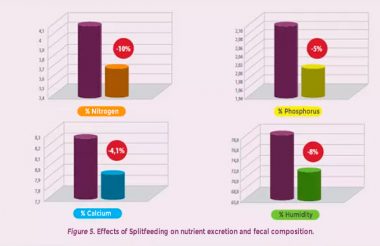Experimental design tests
Content available at:
Español (Spanish) Português (Portuguese (Brazil))
The Splitfeeding method provides an optimal supply of nutrients. By supplying two different diets a day, it satisfies the hen’s nutrient requirements during the egg formation process.
Since 2005, a new layer feeding program, called Splitfeeding, has been developed to satisfy the specific nutritional needs that occur in each phase of egg formation, needs that vary throughout the day.
Laying hens lay most of their eggs during the morning (Etches, 1986; Larbier and Leclercq, 1992). The interval between two successive ovipositions is about 24-26 hours (Keshavarz, 1998). After oviposition, the next ovulation occurs 30 minutes later. The white is formed in the first four hours of the egg formation process, then the egg moves to the uterus where the shell is deposited around the albumin, the duration of this process is approximately 20 hours (Larbier and Leclercq, 1992).
The needs of laying hens for amino acids, energy, calcium and phosphorus do not remain constant but vary throughout the day. Attending to the different needs in nutrients that the hen has for the formation of the different components of the egg. Feeding systems in single-diet layers with constant levels of nutrients may not result in optimal nutrient utilization (Chah, 1972; Leeson and Summers, 1997).
Shell formation takes place mainly during the late afternoon and evening hours.
The result of using Splitfeeding is more profitable egg production due to better shell quality, more eggs suitable for sale, lower production costs and improved production yields.
The nutritional needs of the layers vary during the day depending on the evolution of the egg formation.
Chah (1972) in a study, offered chickens diets in which they could choose nutrients for themselves. The total daily intake of amino acids, energy and calcium was respectively 11%, 8% and 26% lower than in chickens fed a single diet (Figure 1). This suggests that the hen uses energy, amino acids, calcium and phosphorus more efficiently, consuming these nutrients at times of the day when her needs are highest. Therefore, the practice of supplying a single diet may NOT be an appropriate strategy for optimal nutrient utilization.
Experimental design tests
The research work carried out by the team of researchers at the Trouw Nutrition Poultry Research center aimed to accurately determine the nutritional needs of different nutrients during the morning and afternoon when two diets are provided:

Each test was performed with a single nutrient, determining the optimal level of energy, amino acids, calcium and phosphorus for morning and afternoon diets throughout the laying cycle. Compared to the traditional single-diet system, Splitfeeding results in a reduction in total nutrient intake (Figure 2), with productive performance being at least as good as when using a single diet. 


In the three experiments in which the effects of nutrient excretion were studied, the results demonstrated that Splitfeeding is a more sustainable feeding program by reducing the excretion of nitrogen, phosphorus and calcium in the stool (Figure 5). Splitfeeding resulted in lower daily nutrient intake and better use of these nutrients, as these were supplied when the layers needed them. 
With this objective, we supply with Splitfeeding two different diets on the day:
This adaptation of the laying hen’s physiological needs during the day allows the Splitfeeding feeding system to be a more effective feeding program: Splitfeeding provides the optimal supply of nutrients that the hens require during the egg formation process, achieving a more profitable and sustainable egg production. Benefits provided by Splitfeeding:
Subscribe now to the poultry technical magazine
AUTHORS

Layer Longevity Starts at Rearing
H&N Technical Team
The Strategy for a Proper Infectious Bronchitis Control
Ceva Technical Team
Elevate Hatchery Performance with Petersime’s New Data-Driven Incubation Support Service
Petersime Technical Team
Maize and Soybean Meal Demand and Supply Situation in Indian Poultry Industry
Ricky Thaper
Production of Formed Injected Smoked Chicken Ham
Leonardo Ortiz Escoto
Antimicrobial Resistance in the Poultry Food Chain and Novel Strategies of Bacterial Control
Edgar O. Oviedo-Rondón
GREG TYLER INTERVIEW
Greg Tyler
Insights from the Inaugural US-RSPE Framework Report
Elena Myhre
Newcastle Disease: Knowing the Virus Better to Make the Best Control Decisions. Part II
Eliana Icochea D’Arrigo
Avian Pathogenic E. coli (APEC): Serotypes and Virulence
Cecilia Rosario Cortés
The Importance of Staff Training on Animal Welfare Issues in Poultry Industry
M. Verónica Jiménez Grez
Rodent Control is a Key Factor in Poultry Biosecurity and Sustainability
Edgar O. Oviedo-Rondón